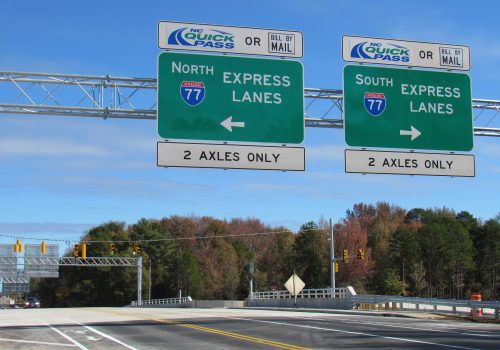
June 14. By Dave Vieser. One of the more heralded congestion remedies which emerged from an I-77 local advisory group in 2020—turning the shoulders into rush-hour lanes—may never happen. The NCDOT is now taking another look at the usefulness of the $47 million project.
“Traffic trends have changed since an initial analysis was conducted,” said DOT Spokeswoman Jen Goodwin. “Therefore, another analysis is currently under way to determine whether peak period shoulder lanes would further improve mobility in the area.”
Background
The project would have widened and hardened the I-77 shoulder from I-485 to Exit 36 in Mooresville. The purpose was to allow the shoulders to be used as general-purpose lanes during the morning and evening commutes, adding needed capacity at peak travel times.
The existing shoulders were not built to accommodate the weight of 18-wheelers, hence the need for “hardening.”
NCDOT not in control

Boisvert
If an analysis points toward the addition of the new lanes, there is still no guarantee that I-77 Mobility Partners, the managed lane authority, will go along with the recommendation. “All I can say at this point is that we will certainly sit and listen to the analysis,” said Rob Boisvert, Mobility Partners spokesman.
The relationship between the two organizations leaves a final decision in doubt.
NCDOT has a management and oversight role, but day-to-day operation is under Mobility’s control. “We are responsible for the corridor from fence to fence,” said Boisvert, meaning they control not only the traffic lanes, but also the median, as well as the areas outside of the shoulders.
Shoulder lanes have been used in various locations across the country to help mitigate traffic congestion. For example, in Colorado, I-70 has an 11-foot-wide shoulder which runs for a distance of 13 miles to handle extra capacity during the holiday and ski seasons.
Increasing traffic

Knox
Officials who participated in the bipartisan meetings about I-77 are quick to note that traffic volume has been on the rise in recent years.
Quotable
“I feel the amount of volume in the managed lanes has increased over the last couple of years due to several factors,“ said Davidson Mayor Rusty Knox. “People are going back to work, they often don’t have the time to sit in the general-purpose lanes and there are just more people here in the Lake Norman region today than two or three years ago.”



